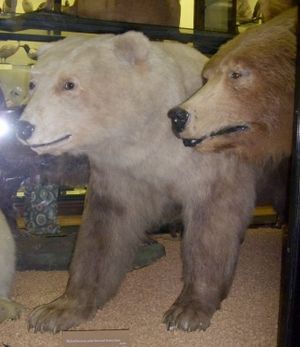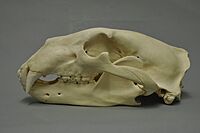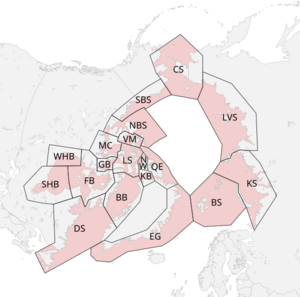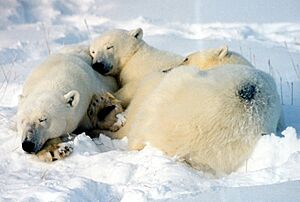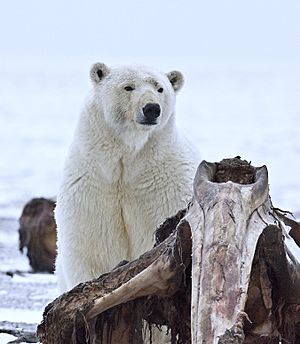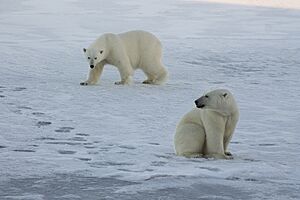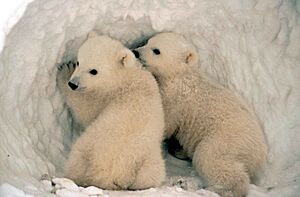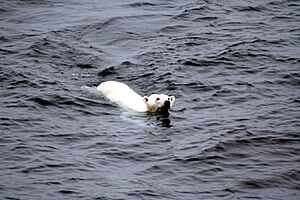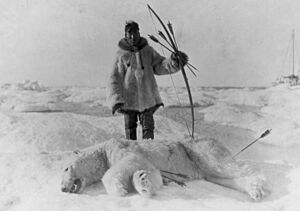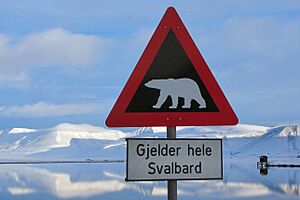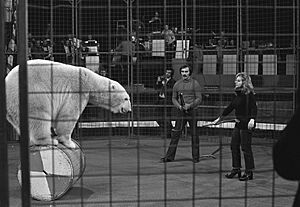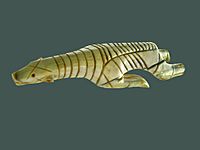Polar bear facts for kids
The polar bear (Ursus maritimus) is a very large bear that lives in the Arctic and nearby cold regions. It's closely related to the brown bear, and they can even have cubs together! Polar bears are the biggest meat-eating animals on land, with adult males weighing between 300 and 800 kilograms (about 660 to 1,760 pounds). Females are much smaller. Polar bears have white or yellowish fur, black skin, and a thick layer of fat to keep them warm. They are built a bit more slender than brown bears, with a longer neck and paws that help them walk on ice and swim.
Polar bears live on both land and ice, and they are considered marine mammals because they depend so much on the ocean. They love living on sea ice, especially the ice that forms each year. When the ice melts in summer, they move to land. They mostly eat meat, especially seals like the ringed seal. They often hunt by waiting quietly near a seal's breathing hole or by sneaking up on them on the ice. They mostly eat the seal's fatty blubber, which gives them lots of energy. Sometimes, they also hunt walruses, beluga whales, and other land animals. Polar bears usually live alone, but they might gather in groups on land. During mating season, male bears protect females from other males. Mothers have their cubs in special dens during winter, and the young stay with their mother for up to two and a half years.
The International Union for Conservation of Nature (IUCN) says the polar bear is a vulnerable species, meaning it's at risk. There are an estimated 22,000 to 31,000 polar bears left. Their biggest problems are climate change, pollution, and energy development. Climate change is causing the sea ice to melt, which makes it harder for polar bears to find their main food source, seals. This can lead to them not getting enough to eat. Less sea ice also means bears spend more time on land, which can lead to more conflicts with people. People have hunted polar bears for their fur, meat, and other parts. They have also been kept in zoos and circuses and are important in art, stories, and different cultures.
Quick facts for kids Polar bearTemporal range:
Late Pleistocene – present (~120,000–0 YBP)
|
|
|---|---|
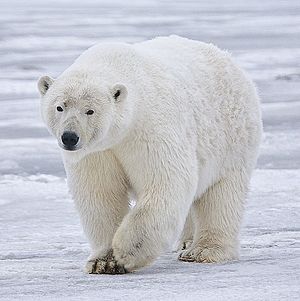 |
|
| Female near Kaktovik, Barter Island, Alaska, United States | |
| Conservation status | |
| Scientific classification | |
| Genus: |
Ursus
|
| Species: |
maritimus
|
| Subspecies | |
|
|
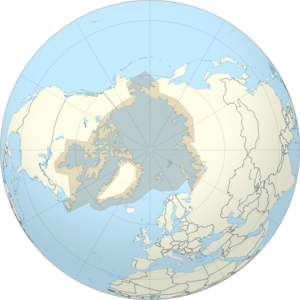 |
|
| Polar bear range | |
| Synonyms | |
|
Ursus eogroenlandicus |
|
Contents
Naming the Polar Bear
The name "polar bear" was first used by Thomas Pennant in 1771. Before that, in Europe, people called it the "white bear," "ice bear," "sea bear," or "Greenland bear." The Norse people called it isbjørn (ice bear) and hvitebjørn (white bear). The Inuit people call it nanook. Some Inuit groups have different names for bears based on their age and sex. For example, adult males are anguraq, and newborns are hagliaqtug. The scientific name, Ursus maritimus, is Latin for "sea bear."
How Polar Bears Evolved
Carl Linnaeus first thought the polar bear was a type of brown bear in 1758. But in 1774, Constantine John Phipps officially described it as its own species, Ursus maritimus, after his trip to the North Pole. Some scientists even thought it should have its own genus, Thalarctos, because it's so well-adapted to the ocean. However, most agree it belongs in the Ursus genus with other bears because of its fossil record and because it can breed with brown bears.
Scientists have studied polar bear fossils, but they are rare. The oldest known fossil is a jaw bone from about 130,000 years ago, found in Norway. For a long time, scientists thought polar bears came directly from brown bears, possibly in Siberia or Alaska.
More recent genetic studies show that polar bears and brown bears are actually separate groups that split a long time ago. The similarities between them are because they sometimes bred together. One study in 2012 suggested they split about 600,000 years ago, and a 2022 study even pushed that back to over one million years ago! Ice ages over thousands of years led to polar bears developing and later mixing with brown bears.
Studies have shown that genes moved from polar bears to brown bears during these times of interbreeding. For example, some brown bears in Alaska got up to 9% of their genes from polar bears. This mixing mostly stopped around 200,000 years ago. Today, modern hybrids (mixes of grizzly and polar bears) are rare in the wild.
Polar bears have special genes that help them live in the Arctic. They have fewer genes for smelling different odors because there are fewer smells in their cold home. Since they eat a lot of fat, they have fewer genes for breaking down starch and more genes for breaking down fat. Their thick fur is also due to more genes that create proteins for hair.
What Polar Bears Look Like
The polar bear is the largest living bear species and the biggest meat-eating animal on land. Some brown bears, like the Kodiak bear, can be similar in size. Males are usually 200–250 cm (6.5–8.2 ft) long and weigh 300–800 kg (660–1,760 lb). Females are smaller, at 180–200 cm (5.9–6.5 ft) long and weighing 150–300 kg (330–660 lb). Males also have bigger heads than females. Polar bears' weight changes throughout the year as they gain and lose fat. A pregnant female can weigh up to 500 kg (1,100 lb). The tallest adults can stand 130–160 cm (4.2–5.2 ft) at the shoulder. The largest polar bear ever recorded weighed 1,002 kg (2,209 lb) and was shot in Alaska in 1960.
Compared to brown bears, polar bears are more slender. They have a narrower, flatter skull, a longer neck, and a lower shoulder hump. Their snout is curved, like a "Roman nose". They have 34–42 teeth, including sharp canines and pointed molars that are good for cutting meat. Their large paws help them walk on snow and ice and paddle in water. Their feet are hairier than other bears', which provides warmth and grip. Their claws are small but sharp, used for catching prey and climbing ice.
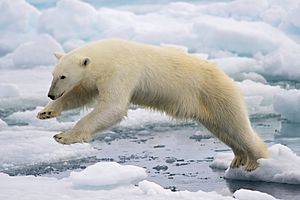
Their coat has dense underfur about 5 cm (2 in) long and longer guard hairs about 15 cm (6 in) long. Males have long hairs on their front legs, which might show how strong and healthy they are to females. The guard hairs are hollow, which helps trap heat and makes the bear float in water. The fur looks white because of how light bounces off it, but the hairs themselves are transparent. They can look yellowish after being in the sun, but this changes after they shed their fur. Their light fur helps them camouflage in snowy places. After swimming, they can shake off water easily because their fur doesn't tangle when wet. Oily secretions keep their hair from freezing. Their skin, including their nose and lips, is black, which helps absorb heat from the sun. Under their skin, they have a 5–10 cm (2–4 in) thick layer of fat for warmth and energy. Polar bears keep their body temperature around 36.9°C (98.4°F). They can cool down by going into the water.
Polar bears' eyes are high on their head, which might help them see while swimming. Their small eyes may protect them from blowing snow and snow blindness. They can see well at night. Their ears are small to help them keep warm and avoid frostbite. They have a great sense of smell, which helps them find prey from far away. Their kidneys are special and help filter salt from their food.
Where Polar Bears Live
Polar bears live in the Arctic and nearby areas, including Greenland, Canada, Alaska, Russia, and Norway's Svalbard Archipelago. They have been seen as close as 25 km (15.5 miles) from the North Pole. The southernmost places they live include James Bay in Canada and St. Matthew Island in Alaska. They don't live permanently in Iceland but sometimes visit if they can reach it by sea ice. Because their habitat is so remote, polar bears still live in most of their original range, more than any other large land carnivore.
Scientists divide polar bears into at least 18 groups called subpopulations. These groups are found across different areas like the Barents Sea, Chukchi Sea, and Hudson Bay. A recent study in 2022 suggested that bears in southeast Greenland might be a separate subpopulation because they are geographically isolated.
Polar bears rely so much on the ocean that they are considered marine mammals. They love sea ice and mostly live on the annual ice that covers continental shelves and between islands. These areas are rich in marine life. They often stay where the sea ice meets the water, like in polynyas (open water areas in ice) and leads (cracks in the ice), to hunt seals. Polar bears move as the ice changes throughout the year. They are forced onto land in summer when the sea ice melts. On land, they use forests, mountains, rocky areas, and beaches. In some areas, like the Chukchi and Beaufort seas, many bears now spend the whole summer on land because the ice breaks up and floats north. Some places have thick, multiyear ice that doesn't melt, and bears can stay there all year, but these areas have fewer seals.
Polar Bear Behavior and Life
Polar bears can travel huge distances, from 3,500 square kilometers (1,350 sq mi) to 38,000 square kilometers (14,670 sq mi) in a year. They can travel about 12 km (7.5 miles) per day. They walk and gallop, moving at about 5.5 km/h (3.4 mph) but can run up to 40 km/h (25 mph). Polar bears are also excellent swimmers, reaching speeds of 6 km/h (3.7 mph). One study found they can swim for an average of 3.4 days at a time, covering about 154.2 km (95.8 miles). They can dive underwater for up to three minutes. When swimming, their large front paws do most of the paddling, and their back legs help steer.
Most polar bears are active all year. Only pregnant females hibernate. Bears that don't hibernate usually follow a normal 24-hour day-night cycle, even during the dark winter or sunny summer. They are generally most active early in the day. Polar bears sleep about eight hours a day. They can sleep in many positions, like curled up or lying on their back. On sea ice, they often rest in sheltered spots near ice ridges. After a snowstorm, a bear might rest under the snow for hours or days. On land, they might dig a resting spot on beaches or rocky areas. Mothers and young bears often sleep on slopes in mountainous areas to spot other bears coming. Adult males are less worried about other bears and can sleep almost anywhere.
Social Life
Polar bears usually live alone, except for mothers with cubs and mating pairs. When they are on land, they might be found closer together, especially around food. Adult males are more tolerant of each other on land and outside of mating season. They have even been seen forming "alliances," traveling, resting, and playing together. There's a pecking order among polar bears, with the largest adult males at the top. Adult females are higher in rank than younger bears. Females with cubs tend to stay away from males but sometimes join other female-cub groups.
Polar bears are usually quiet but can make different sounds. Mothers make a soft pulsing sound called "chuffing" to stay in touch with their cubs. During mating season, males chuff at females. Cubs cry for attention and hum while nursing. In more aggressive situations, bears might make teeth chops, growls, or roars. Polar bears also communicate with their eyes, ears, nose, and lips. They can also leave their scent from their foot pads in their tracks, which helps other bears know who's been there.
What Polar Bears Eat and How They Hunt
The polar bear is a hypercarnivore, meaning it eats mostly meat. It's the top predator in the Arctic. They hunt ice-living seals and eat their fatty blubber. The most common prey is the ringed seal, but they also eat bearded seals and harp seals. Ringed seals are perfect because they are common and small enough for even smaller bears to catch. Adult bearded seals are bigger and harder to catch, so adult male bears are better at hunting them. Less common prey include hooded seals, spotted seals, and ribbon seals. Polar bears, especially adult males, sometimes hunt walruses on land and ice, usually targeting young ones because adults are too big and strong.
Besides seals, bears sometimes hunt beluga whales and narwhals, as well as reindeer, birds and their eggs, fish, and small sea creatures. They rarely eat plants because their digestive system is made for meat. However, they have been seen eating berries, moss, grass, and seaweed. In their southern range, like near Hudson Bay, polar bears have to go months without sea ice to hunt from, so they eat more land-based foods. Their fat reserves help them survive for months without eating. Sometimes, polar bears will even eat other polar bears.
Polar bears hunt in different ways. When a bear sees a seal resting on the ice, it slowly sneaks up with its head down to hide its dark nose and eyes. As it gets closer, the bear crouches and then charges quickly to catch the seal before it can escape into its ice hole. Some bears might swim through water channels in the ice to get closer to a seal. A polar bear can stay underwater with just its nose showing. When it's close enough, it lunges from the water to attack.
In spring, polar bears look for ringed seal pups hidden in their dens under the ice. Once a bear smells a pup, it quietly approaches the den. It uses its front paws to smash through the ice and then pokes its head in to catch the pup. A seal's den can be over 1 meter (3.3 ft) deep, so bigger bears are better at breaking in. Some bears simply wait still near a breathing hole or ice edge for prey to come by. This can last for hours. When a seal surfaces, the bear tries to pull it out with its paws and claws. This is their main hunting method from winter to early spring.
Bears hunt walrus groups by making them stampede, then they look for young walruses that have been crushed or separated from their mothers. There are stories of bears trying to kill walruses by throwing rocks and ice at them. Belugas and narwhals are easy targets when they get stuck in shallow water or isolated breathing holes in the ice. When hunting reindeer, polar bears hide in plants before ambushing them. Sometimes, bears try to catch prey in open water, swimming under a seal or bird. However, seals are faster than bears in the water. Polar bears use their raw strength to kill prey, using bites and paw swipes. They are strong enough to pull a medium-sized seal out of the water or drag a beluga carcass a long way. Polar bears only sometimes store food for later, burying it under snow, and only for a short time.
Arctic foxes often follow polar bears to eat scraps from their kills. The bears usually let them, but will chase a fox that gets too close while they are eating. Polar bears also eat scavenged food. Younger bears often eat leftovers from other bears. Females with cubs might leave a carcass if a larger male approaches, unless they are very hungry. Whale carcasses are a valuable food source, especially on land after the sea ice melts, and they attract many bears. In Alaska, polar bears have been seen competing with grizzly bears for whale carcasses. Even though grizzlies are smaller, they are more aggressive, and polar bears often give way to them. Polar bears will also look for food at garbage dumps when there is no ice.
Reproduction and Life Cycle
Polar bears mate on the sea ice, mostly between March and May. Males search for females ready to mate and often travel in twisting paths to avoid other males while still finding females. Females travel in straighter lines and cover more ground.
When a male finds a female, he tries to keep her away from other males. Courtship can be a bit rough, and the male will chase the female if she tries to run. It can take days for the male to mate with the female, which causes her to release eggs. After their first mating, the pair stays together. They usually stay together for about two weeks, sleeping and mating many times. Competition for mates is strong, which is why male polar bears are so big. Males often have scars from fighting. A bonded pair will run away together if another male shows up. A female might mate with several males in one season, and a single litter of cubs can have more than one father.
After mating season, the female eats a lot to build up fat reserves for herself and her cubs. Between August and October, the female builds and enters a maternity den for winter. These dens can be in sea ice near the coast or further inland, dug under snow, earth, or both. The inside of the den can be about 1.5 meters (5 ft) wide and 1.2 meters (4 ft) high. The den's temperature can be much warmer than outside. Females hibernate and give birth in these dens. While hibernating, they don't eat and their bodies recycle waste. Polar bears have delayed implantation, meaning the fertilized egg doesn't start developing until fall, usually between mid-September and mid-October. So, while gestation lasts 7 to 9 months, the actual pregnancy is only two months.
Mother polar bears usually give birth to two cubs per litter. Like other bear cubs, newborn polar bears are tiny and helpless. They have woolly hair and pink skin, weighing about 600 grams (1.3 lb). Their eyes stay closed for a month. The mother's fatty milk helps them grow quickly, and the den and her body heat keep them warm. The mother comes out of the den between late February and early April, and her cubs are well-developed and can walk with her. At this time, they weigh 10–15 kg (22–33 lb). A polar bear family stays near the den for about two weeks. During this time, the cubs play while the mother mostly rests. Then, they head out onto the sea ice.
Cubs under a year old stay close to their mother. When she hunts, they stay still and watch. This helps them learn hunting skills. After their first year, they become more independent and explore. By about two years old, they can hunt on their own. The young drink milk from their mother while she lies on her side or sits. A mother bear cannot get pregnant again while she is nursing cubs. Cubs are weaned (stop drinking milk) between two and two and a half years old. The mother might just leave her weaned young, or a male trying to mate with her might chase them away. Female polar bears can start having cubs at about four years old, and males are ready to mate at six years old. Females reach their full size at 4 or 5 years old, while males take twice as long.
Mortality
Polar bears can live up to 30 years. Their long lifespan and ability to have cubs regularly help balance out cub deaths. Some cubs die in the dens or before birth if the mother isn't healthy. However, if she eats better the next year, she can still have a healthy litter. Cubs can starve if their mothers can't catch enough prey. Cubs also face dangers from wolves and adult male bears. Males sometimes kill cubs to make the mother ready to mate again, but they also kill young bears for food outside of mating season. A mother and her cubs can usually run away from a slower male. If a male gets too close to a cub, the mother might fight him off, sometimes risking her own life.
Young bears who are independent but not yet fully grown have a tough time. They aren't as good at hunting as adults, and even when they catch something, a bigger bear might steal it. So, these young bears often have to scavenge and are at risk of starving. Once polar bears reach adulthood, they have a high survival rate, though adult males can get injured from fights over mates. Polar bears can get a parasitic roundworm called Trichinella from eating other bears.
Protecting Polar Bears
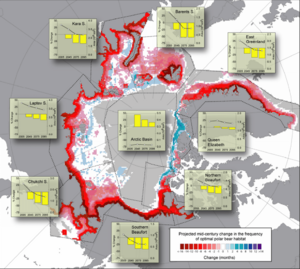
In 2015, the IUCN Red List listed the polar bear as vulnerable. This means their habitat is shrinking, and their numbers might be declining. The total population was estimated to be between 22,000 and 31,000. The biggest threats to polar bears are climate change, pollution, and energy development.
In 2021, a group of polar bear experts said that some groups of polar bears were "likely stable" or "likely increased," while others, like those in the Southern Beaufort Sea and Hudson Bay, were "likely decreased." For many groups, there wasn't enough information. A 2008 study predicted that two-thirds of the world's polar bears might disappear by 2050 because of melting sea ice. A 2016 study also predicted a likely decline of over 30% in three generations. A 2020 study suggested that if global warming continues at a high rate, most polar bear groups could disappear by 2100.
The main danger from climate change is that bears won't get enough food. Polar bears hunt seals on sea ice. Rising temperatures cause the ice to melt earlier, forcing bears to shore before they have stored enough fat to last through the summer and fall when food is scarce. Thinner ice also breaks more easily, making it harder for bears to reach seals. Not enough food leads to fewer cubs being born and lower survival rates for cubs and young bears. When bears can't find seals, they look for food on land, which increases conflicts with humans. A 2024 study found that eating more land-based foods during longer warm periods probably won't give them enough energy, increasing the risk of starvation. Young bears are especially at risk.
Less sea ice also means bears have to swim longer distances, which uses up their energy and can sometimes lead to drowning. Changes in ice movement can also make it harder for mothers to find stable places for their dens or travel to and from dens on land. Melting permafrost could make underground dens less safe. Less snow might mean less insulation, and more rain could cause dens to collapse. Stress levels in polar bears have increased with climate warming. Diseases and parasites could also spread more easily in a warmer climate.
Oil and gas development also affects polar bear habitats. Areas with a lot of drilling, like the Chukchi Sea in Alaska, are important for female bears. Oil spills are also a risk. A 2018 study found that a large oil spill could affect nearly 40% of the polar bear population. Polar bears also build up high levels of harmful chemicals like polychlorinated biphenyl (PCBs) and chlorinated pesticides in their bodies because they are at the top of the food chain. Many of these chemicals are now banned, and their levels in polar bears have slowly gone down, but they still exist and have even increased in some groups.
Polar bears are legally protected in all the countries where they live. In the US, they have been listed as 'threatened' since 2008. In 1973, Canada, Denmark (Greenland), Russia, Norway, and the US signed the Agreement on the Conservation of Polar Bears. This agreement banned most hunting of polar bears, but allowed indigenous people to hunt using traditional methods, and promoted protecting bear habitats. The Convention on International Trade in Endangered Species of Wild Fauna lists polar bears under Appendix II, which means their trade is regulated.
Polar Bears and Humans
Polar bears and circumpolar peoples have lived together for thousands of years. "White bears" were mentioned in a Japanese book in the 7th century, though it's not clear if they were polar bears. During the Middle Ages, Europeans saw white bears as special. The first written account of a polar bear in its natural home was in a 13th-century Norwegian text, which described it as a skilled swimmer.
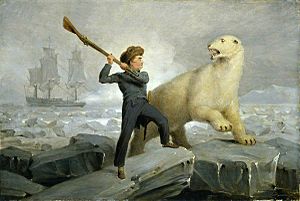
Over the centuries, European explorers wrote more about polar bears, and some were brought back alive or dead. However, some strange stories continued, like the idea that polar bears cover their noses when hunting. A good drawing of a polar bear appeared in Henry Ellis's book in 1748. Constantine John Phipps officially classified polar bears as a species after his 1773 trip to the Arctic. A young Horatio Nelson was with him and wanted a polar bear coat for his father. In 1785, Comte de Buffon wrote about "sea bears" (polar bears) and "land bears" (brown and black bears), which helped people understand different species.
Hunting and Use
People have hunted polar bears for at least 8,000 years. The oldest drawing of a polar bear shows a man hunting it with three dogs in Siberia, dating back to the 5th to 8th centuries. Before firearms, native people used spears, bows and arrows, and hunted in groups with dogs. They sometimes killed swimming bears from boats with harpoons or hunted them in their dens. Killing a polar bear was a special event for boys in some cultures. Native people respected the animal, and hunts followed strict rituals. Bears were hunted for their fur, meat, fat, tendons, bones, and teeth. The fur was used for clothes and bedding, and bones and teeth were made into tools. Some people even kept the cubs of bears they killed.
Norsemen in Greenland traded polar bear furs in the Middle Ages. Russia traded polar bear products as early as 1556. Large-scale hunting at Svalbard began in the 18th century, with over 150 bears killed each year by Russian explorers. From the 1870s to the 1970s, about 22,000 bears were hunted there. Over 150,000 polar bears were killed or captured in Russia and Svalbard from the 18th to the 20th century. In the Canadian Arctic, commercial whalers also hunted bears. The Hudson's Bay Company sold about 15,000 polar bear coats between the late 1800s and early 1900s. In the mid-20th century, countries started to control polar bear hunting, leading to the 1973 agreement.
Polar bear meat was often eaten by explorers and sailors in the Arctic. Some found it too strong, while others called it a "royal dish." The liver was known to be poisonous because it contains too much vitamin A. Polar bear fat was also used in lamps when other fuel wasn't available. Polar bear rugs were common in Norwegian churches in the 13th and 14th centuries. In more modern times, Hollywood actors like Marilyn Monroe posed on bearskin rugs, often with a suggestive meaning.
Conflicts with Humans
When sea ice melts, polar bears, especially young ones, sometimes come into conflict with humans on land. They are attracted to the smell of human food, especially at garbage dumps, and might be shot if they enter private property. In Churchill, Manitoba, local authorities have a "polar bear jail" where they hold problem bears until the sea ice freezes again. Climate change has increased these conflicts. In February 2019, over 50 polar bears swarmed a town in Russia, causing a state of emergency.
From 1870 to 2014, there were about 73 polar bear attacks on humans, leading to 20 deaths. Most attacks were by hungry males, usually young ones. Female attacks were usually to protect their cubs. Compared to brown and American black bears, polar bear attacks often happened near human homes. This might be because hungry bears are more likely to look for food in human settlements. Like other bears, polar bears are unlikely to attack more than two people at once. Even though they are often seen as the most dangerous bear, polar bears are not more aggressive towards humans than other bear species.
Polar Bears in Zoos
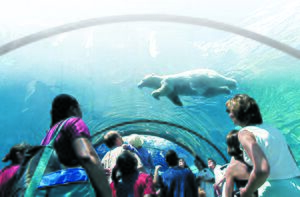
Polar bears were highly sought after by animal collectors because they were rare and lived in remote areas, and they had a reputation as fierce animals. They are one of the few marine mammals that reproduce well in captivity. Originally, only kings and queens kept them. The Tower of London had a polar bear as early as 1252. In 1609, King James VI and I received two polar bear cubs. In the late 17th century, Frederick I of Prussia kept polar bears in his animal collections. He had their claws and canines removed so they could perform mock fights safely. Around 1726, Catherine I of Russia gave two polar bears to Augustus II of Poland for his collection. Later, polar bears were shown to the public in zoos and circuses. The first zoo in North America to have a polar bear was the Philadelphia Zoo in 1859.
Zoo exhibits for polar bears improved when Carl Hagenbeck started replacing cages with settings that looked like the animals' natural homes. In 1907, he created a large exhibit at the Tierpark Hagenbeck Zoo in Hamburg with artificial snow and ice, separated by moats. Different Arctic animals were displayed, making it seem like they lived together. Starting in 1975, the Hellabrunn Zoo in Munich had an exhibit with a glass barrier, a house, concrete platforms like ice floes, and a large pool. The house had dens for mothers and rooms for staff to prepare food. Similar natural-looking exhibits opened in the early 21st century, like the "Arctic Ring of Life" at the Detroit Zoo. Many zoos in Europe and North America have stopped keeping polar bears because their exhibits are so large and expensive. In North America, the number of polar bears in zoos peaked in 1975 with 229 animals and has since declined.
Polar bears have also been trained to perform in circuses. Bears were popular in circuses because they are large, strong, easy to train, and look somewhat human-like. The white coat of polar bears made them especially appealing. Circuses helped change the polar bear's image from a scary monster to something more funny. Performing polar bears were used by Circus Krone in Germany in 1888 and later by the Bostock and Wombwell Menagerie in England in 1904. Circus director Wilhelm Hagenbeck trained up to 75 polar bears to slide into a large tank. He started performing with them in 1908, and they had a very popular show in London. Other tricks performed by polar bears included tightropes, balls, roller skates, and motorcycles. One of the most famous polar bear trainers in the late 20th century was Ursula Böttcher from East Germany, whose small size was a contrast to the large bears. Since the late 20th century, most polar bear acts have stopped, and using these bears for circuses is now banned in the US.
Several captive polar bears became famous in the late 20th and early 21st centuries. Knut of the Berlin Zoological Garden was rejected by his mother and had to be raised by zookeepers. Another bear, Binky of the Alaska Zoo, became famous for attacking two visitors who got too close. Captive polar bears sometimes pace back and forth, which is a repetitive behavior. In one study, they spent 14% of their day pacing. Gus of the Central Park Zoo was even given medication for constantly swimming in his pool. To reduce these behaviors, zookeepers give bears toys and activities to encourage natural play. In warm conditions, algae can grow in their fur, making zoo polar bears appear green.
Polar Bears in Culture
Polar bears are very important in Inuit culture and religion. The god Torngarsuk is sometimes seen as a giant polar bear. He lives under the sea and has power over sea creatures. Inuit shamans would worship him through singing and dancing. Polar bears were also linked to the goddess Nuliajuk, who created them and other sea creatures. It was believed that shamans could travel to the Moon or the bottom of the ocean by riding a guardian spirit in the form of a polar bear. Some stories tell of people turning into polar bears by wearing their skins, or polar bears taking off their skins to become human. In Inuit astronomy, the Pleiades star cluster is seen as a polar bear trapped by dogs, while Orion's Belt and other stars represent hunters, dogs, and a wounded bear.
Nordic folklore and literature also feature polar bears. In The Tale of Auðun of the West Fjords (around 1275), a poor man buys a polar bear in Greenland and becomes rich after giving it to the king of Denmark. In a 14th-century manuscript, a man named Odd kills and eats a polar bear that killed his father and brother. The story of The Grimsey Man and the Bear tells of a mother bear who nurses and rescues a farmer stuck on an ice floe, and he repays her with sheep meat. 18th-century Icelandic writings mention a legend of a "polar bear king" with "ruddy cheeks" and a glowing, unicorn-like horn. This king was thought to be very smart and could understand humans. Two Norwegian fairy tales, "East of the Sun and West of the Moon" and "White-Bear-King-Valemon", involve white bears turning into men and falling in love with women.
Drawings of polar bears have appeared on maps of northern regions. Perhaps the earliest is on the Swedish Carta marina of 1539, showing a white bear on Iceland. A 1544 map of North America includes two polar bears near Quebec. Famous paintings featuring polar bears include François-Auguste Biard's Fighting Polar Bears (1839) and Edwin Landseer's Man Proposes, God Disposes (1864). Polar bears have also been in movies. An Inuit polar bear hunt was filmed for the 1932 documentary Igloo. In the 1974 film The White Dawn, a trained bear was used for a simulated stabbing scene. In the film The Big Show (1961), two characters are killed by a circus polar bear, with animal trainers standing in for the actors. In modern books, polar bears are characters in children's fiction, like Hans Beer's Little Polar Bear and the Whales and Sakiasi Qaunaq's The Orphan and the Polar Bear, and fantasy novels, like Philip Pullman's His Dark Materials series. On radio, Mel Blanc voiced Jack Benny's pet polar bear Carmichael. The polar bear is featured on flags and coats of arms, like the coat of arms of Greenland, and in many advertisements, especially for Coca-Cola since 1922.
As popular and recognizable animals, polar bears have been used to raise awareness about the dangers of climate change. Aurora the polar bear is a giant marionette created by Greenpeace for climate protests. The World Wide Fund for Nature sells plush polar bears as part of its "Arctic Home" campaign. Photographs of polar bears have been in National Geographic and Time magazines, including pictures of them on melting ice floes. The climate change documentary An Inconvenient Truth (2006) includes an animated bear swimming. Automobile company Nissan used a polar bear in a commercial, hugging a man for using an electric car. To make a statement about global warming, in 2009, an ice statue of a polar bear with a bronze skeleton was purposely left to melt in the sun in Copenhagen.
See also
 In Spanish: Oso polar para niños
In Spanish: Oso polar para niños
- 2011 Svalbard polar bear attack
- International Polar Bear Day
- List of individual bears – includes individual captive polar bears
- Polar Bears International – a group that works to protect polar bears
- Polar Bear Shores – an exhibit featuring polar bears at Sea World in Australia



